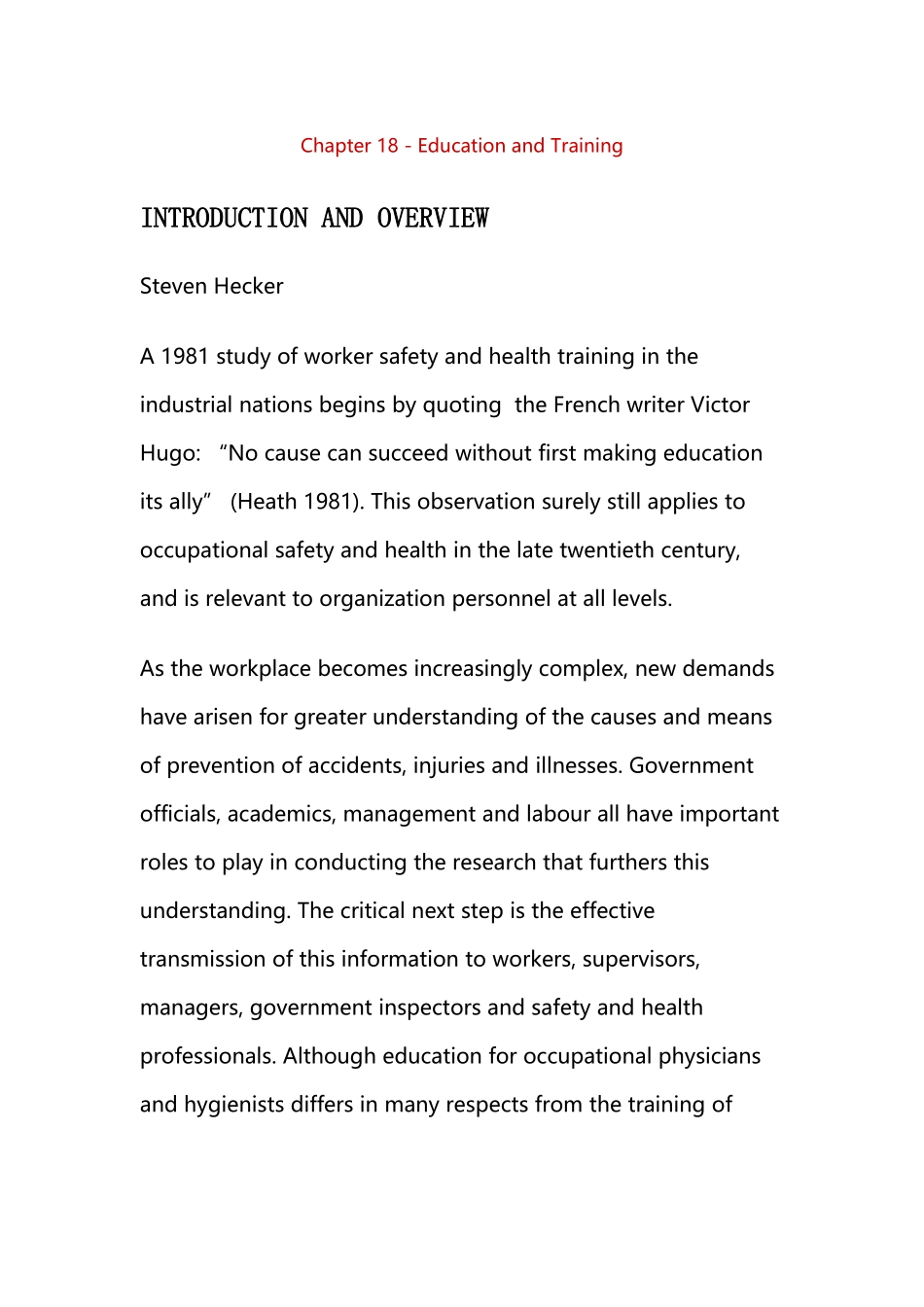Chapter18-EducationandTrainingINTRODUCTIONANDOVERVIEWStevenHeckerA1981studyofworkersafetyandhealthtrainingintheindustrialnationsbeginsbyquotingtheFrenchwriterVictorHugo:“Nocausecansucceedwithoutfirstmakingeducationitsally”(Heath1981).Thisobservationsurelystillappliestooccupationalsafetyandhealthinthelatetwentiethcentury,andisrelevanttoorganizationpersonnelatalllevels.Astheworkplacebecomesincreasinglycomplex,newdemandshavearisenforgreaterunderstandingofthecausesandmeansofpreventionofaccidents,injuriesandillnesses.Governmentofficials,academics,managementandlabourallhaveimportantrolestoplayinconductingtheresearchthatfurthersthisunderstanding.Thecriticalnextstepistheeffectivetransmissionofthisinformationtoworkers,supervisors,managers,governmentinspectorsandsafetyandhealthprofessionals.Althougheducationforoccupationalphysiciansandhygienistsdiffersinmanyrespectsfromthetrainingofworkersontheshopfloor,therearealsocommonprinciplesthatapplytoall.Nationaleducationandtrainingpoliciesandpracticeswillofcoursevaryaccordingtotheeconomic,political,social,culturalandtechnologicalbackgroundofthecountry.Ingeneral,industriallyadvancednationshaveproportionallymorespecializedoccupationalsafetyandhealthpractitionersattheirdisposalthandothedevelopingnations,andmoresophisticatededucationandtrainingprogrammesareavailabletothesetrainedworkers.Moreruralandlessindustrializednationstendtorelymoreon“primaryhealthcareworkers”,whomaybeworkerrepresentativesinfactoriesorfieldsorhealthpersonnelindistricthealthcentres.Clearly,trainingneedsandavailableresourceswillvarygreatlyinthesesituations.However,theyallhaveincommontheneedfortrainedpractitioners.Thisarticleprovidesanoverviewofthemostsignificantissuesconcerningeducationandtraining,includingtargetaudiencesandtheirneeds,theformatandcontentofeffectivetrainingandimportantcurrenttrendsinthefield.TargetAudiencesIn1981,theJointILO/WHOCommitteeonOccupationalHealthidentifiedthethreelevelsofeducationrequiredinoccupationalhealth,safetyandergonomicsas(1)awareness,(2)trainingforspecificneedsand(3)specialization.Thesecomponentsarenotseparate,butratherarepartofacontinuum;anypersonmayrequireinformationonallthreelevels.Themaintargetgroupsforbasicawarenessarelegislators,policymakers,managersandworkers.Withinthesecategories,manypeoplerequireadditionaltraininginmorespecifictasks.Forexample,whileallmanagersshouldhaveabasicunderstandingofthesafetyandhealthproblemswithintheirareasofresponsibilityandshouldknowwheretogoforexpertassistance,managerswithspecificresponsibilityforsafetyandhealthandcompliancewithregulationsmayneedmoreintensivetraining.Similarly,workerswhoserveassafetydelegatesormembersofsafetyandhealthcommitteesneedmorethanawarenesstrainingalone,asdogovernmentadministratorsinvolvedinfactoryinspectionandpublichealthfunctionsrelatedtotheworkplace.Thosedoctors,nursesand(especiallyinruralanddevelopingareas)nonphysicianprimaryhealthcareworkerswhoseprimarytrainingorpracticedoesnotincludeoccupationalmedicinewillneedoccupationalhealtheducationinsomedepthinordertoserveworkers,forexamplebybeingabletorecognizework-relatedillnesses.Finally,certainprofessions(forexample,engineers,chemists,architectsanddesigners)whoseworkhasconsiderableimpactonworkers’safetyandhealthneedmuchmorespecificeducationandtrainingintheseareasthantheytraditionallyreceive.Specialistsrequirethemostintensi...



 优质VIP
优质VIP 优质VIP
优质VIP 优质VIP
优质VIP 优质VIP
优质VIP 优质VIP
优质VIP 优质VIP
优质VIP 优质VIP
优质VIP 优质VIP
优质VIP 优质VIP
优质VIP 优质VIP
优质VIP